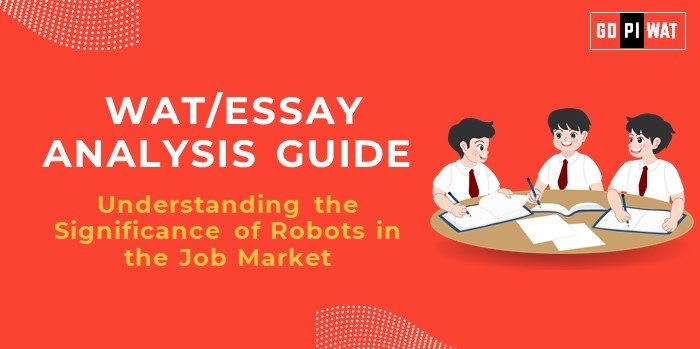📋 Understanding the Significance of Robots in the Job Market
The debate around whether robots will dominate the job market goes beyond simple automation; it explores the core of economic stability, workforce evolution, and the adaptability of industries in the face of rapid technological advancement. For B-school students, this topic encourages an analysis of market dynamics, social responsibility, and the role of innovation in shaping employment trends.
📝 Effective Planning and Writing
- 🕒 Time Allocation (30 minutes):
- 📝 Planning: 5 minutes
- ✍️ Writing: 20 minutes
- 🔍 Review: 5 minutes
- 💡 Preparation Tips:
- 📊 Note key statistics and trends in automation and employment.
- 🧑🤝🧑 Identify relevant stakeholders and their roles.
- 📋 Outline the argument structure: Introduction, Body, and Conclusion.
🔍 Introduction Techniques for Essays
- ⚖️ Contrast Approach: “While AI-driven robots enhance productivity and fill labor shortages in certain sectors, they also raise significant concerns about job displacement in lower-skilled roles. This contrast defines the core challenge of integrating robotics in the workforce.”
- 💡 Solution-Based Introduction: “The future job market may not solely be dominated by robots but will be defined by the adaptability of our workforce and education systems. The key lies in preparing for an AI-augmented workplace rather than fearing it.”
- 🕰️ Timeline Approach: “From the industrial revolution to the digital age, technological advancements have always reshaped job markets. The rise of robots and AI today mirrors past transformations, bringing both challenges and opportunities for future employment.”
🛠️ Structuring the Essay Body
🏆 Achievements of Automation
- 📈 Increased Efficiency: Robots excel in performing repetitive and hazardous tasks, leading to higher productivity. For example, Amazon’s use of robotics in logistics has significantly sped up operations and reduced costs.
- 👨💻 New Job Creation in High-Skill Sectors: The demand for roles in AI programming, data science, and cybersecurity has surged, showcasing automation’s capacity to generate employment in specialized fields.
- 🛡️ Improved Workplace Safety: Robots handle dangerous tasks in industries like mining, construction, and manufacturing, reducing accident rates and enhancing worker safety.
⚠️ Challenges with Automation
- 📉 Potential Job Displacement: Lower-skilled roles, especially in manufacturing and logistics, face a high risk of automation, leading to potential unemployment in these sectors.
- 📚 Skill Gaps and Inequality: The shift towards AI and robotics requires specialized skills, widening the gap between high-skill and low-skill workers. Countries with advanced retraining programs, like Germany, demonstrate how proactive measures can help address this.
- 🌍 Economic and Social Disparities: Regions or countries that lack resources for workforce retraining may face heightened unemployment, social instability, and economic inequality.
🚀 Future Outlook and Recommendations
- 🎓 Promote Inclusive Skill Development: Governments and corporations should collaborate on reskilling programs focused on digital literacy and AI-related competencies, especially for vulnerable populations.
- ⚖️ Encourage Ethical AI Implementation: Establish ethical frameworks and standards for AI integration in decision-making roles, ensuring transparency and responsibility.
- 🔄 Adopt a Balanced Approach to Automation: The future job market can thrive by combining robotic efficiency with human adaptability, focusing on augmenting human roles rather than replacing them entirely.
🔚 Concluding Effectively
- ⚖️ Balanced Perspective Conclusion: “While the adoption of robotics and AI is likely to reshape the job market significantly, its success depends on our ability to address displacement through skill development and adaptive policy. The future may belong not to robots alone but to a human-robot synergy in the workplace.”
- 🌍 Global Comparison Conclusion: “Countries like Japan and Germany demonstrate that robotics can be integrated successfully with proactive workforce policies. As automation accelerates, a balanced approach focusing on retraining and ethical AI practices will ensure that human employment remains central to economic growth.”
📊 Analyzing Successes and Shortcomings
- 🏆 Key Achievements: Enhanced productivity, job creation in AI and tech, and improved workplace safety.
- ⚠️ Ongoing Challenges: Job displacement, skill gaps, and economic inequalities due to unequal access to reskilling resources.
- 🌍 Global Context: Compared to the US, Europe’s emphasis on vocational training and public support for workforce retraining has allowed for smoother integration of automation without significant increases in unemployment.
📈 Recommendations for Sustainable Progress
- 🎓 Support Reskilling Initiatives: Governments should fund training programs for workers in sectors at high risk of automation.
- ⚖️ Create AI Standards and Regulations: Establish ethical standards and guidelines for companies implementing AI to protect both workers and consumers.
- 👥 Encourage Corporate Responsibility: Businesses should prioritize workforce transitions, adopting a human-centered approach to automation that emphasizes job augmentation rather than pure replacement.
📝 Sample Short Essays on Robot Job Market Domination
- ⚖️ Balanced Perspective: “While robots will inevitably handle repetitive tasks in the future job market, roles requiring creativity, strategic thinking, and empathy will remain human-driven. This evolving synergy offers a more productive yet inclusive approach to employment.”
- 🔧 Solution-Oriented Approach: “Robots may dominate certain sectors, but with proactive policies and educational reforms, we can equip the workforce to thrive in a tech-augmented job market. Emphasizing adaptability and digital skills will be key to sustaining employment opportunities.”
- 🌍 Global Comparison: “Looking at automation leaders like Japan and Germany, it’s clear that successful integration of robotics into the workforce requires not just technology but a commitment to workforce development and social responsibility.”


